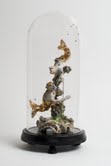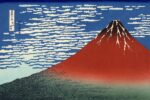Bouke De Vries – Signs (Metamorphosis)

Mostra personale
Comunicato stampa
The Ram, the Bull, the Heavenly Twins,
And next the Crab, the Lion shines,
The Virgin and the Scales.
The Scorpion, Archer, and the Goat,
The Man who holds the Watering-Pot,
And Fish with glittering scales.
The signs of the Zodiac have held an enduring fascination over mankind since the days of classical Greece, with their roots stretching far beyond to the ancient Babylonians. It is extraordinary to think that in this advanced technical age, in which conventional religion is increasingly questioned, the symbolism of these celestial co-ordinates can continue to hold such powerful meaning and importance for so many people around the world, who closely identify them with the course of their daily lives. If we are to believe astrologers, the Zodiac defines our personality, our love affairs and ultimately our individual and collective fate. Even the most reasoned individual cannot but take a strange fascination in how their horoscope manages to be so uncannily ‘accurate’ in relating to the events and social dynamics of their own life on a particular day. This is perhaps because with the Zodiac one is dealing with archetypes. As the psychoanalyst Carl Jung wrote: ‘O ne who speaks in archetypes speaks with thousand voices. He transforms elements arising from the world of simultaneous and inconstant into manifestations of the eternal, simultaneously elevating his own destiny to the scale of humanity at large.’
In his series of twelve sculptures based on the Zodiac, Bouke de Vries has drawn on myths and traditional symbolic imagery to find new ways of representing these archetypal beings, or constellations, in object form. The nature of his presentation, a fusion of disparate ceramic fragments and other elements drawn from myriad sources, some hundreds of years apart, reminds us of the difficulty of pinning down meaning. How we understand the Zodiac is not as one fixed thing, but as an accretion of cultural histories. Through his skilled knowledge of the techniques of ceramics conservation de Vries has created new narrative possibilities and values from once priceless objects whose fracture has rendered them ‘worthless’ and beyond conventional repair. Like the Medieval alchemists who sought to transform base matter into gold (indeed, often turning to the Zodiac for guidance), de Vries work physically manifests this metamorphosis from one state of being and meaning to another.
In considering this series, it is interesting to go back to the roots of our language, for metamorphosis comes from the Greek for ‘transformation’, or literally ‘change form’, while the term zodiac comes from Greek zõdiakos kulos – meaning ‘circle of animals’ after the ring of constellations of stars which is the course of the sun across the celestial sphere during the year. Although predominantly animals, several of the zodiac are in fact hybrids of forms, which combine the body parts of more than one real species. Bouke de Vries has explored the idea of hybrid creatures previously with his series of chimeras, inspired by the mythical animals composed of the parts of multiple animals that appear in Homer’s Iliad. The assemblage nature of his work at once references what André Breton called Surrealism’s ‘conjoining of distant realities’, Medieval reliquaries and the Renaissance and Baroque Wunderk ammer, or ‘Cabinet of Curiosities’, in which precious and strange collections might be displayed together for the delight of the collector and their guests. One of the principal influences on the artist was a visit made to the Wunderkammer’s modern equivalent, Ripley’s ‘Believe it or Not’ in New Orleans, where he was fascinated and amused by the bizarre specimens on show, such as two-headed lambs and other composite creatures. Twenty years later it has emerged in de Vries’ witty sculpture of Pisces featuring two mermaids chained together. These figurines are not beautiful sirens, but hybrids telling a more complex cultural history. The heads of two porcelain monkeys have been fused with fish tails encrusted with gilt mosaic, recalling the supposed remains of ‘mermaids’ that were actually the torso and head of a baby monkey sewn to the back half of a fish and covered in papier-mâche, such as the infamous ‘Fiji Mermaid& rsquo;, popularised by the circus impresario P.T. Barnum in a tour of the USA from 1842.
Theriocephaly (having the head of an animal but the body of a human or God) abounds in Bouke de Vries’ Zodiac. An eighteenth-century Derby figure with a later lion’s head topped with an exquisite specially-made silver crown represents the lion-king Leo, while Aries has a ram’s head, but the body of a Ming figure of the Goddess Guan Yin, who in Chinese Buddhism was originally a man and subsequently a woman, and here is changing again. In a conflation of ancient myths de Vries presents this golden-haired, winged ram knitting the Golden Fleece, which is taken by Jason and the Argonauts. Classical legend also inspired the presentation of Taurus as the Minotaur that dwelt at the centre of the Labyrinth built for King Minos of Crete and was described by the Roman poet Ovid as ‘part man and part bull’. The figure has a bull’s head, horns of fossilised tiger teeth, and the body of a Han Dynasty (206 B.C. – 22 A.D.) Chinese figure holding a bo ok emblazoned with the word ‘Labyrinth’. Around him is spun silver wire, recalling the ball of thread that Ariadne gave the hero Theseus to help him navigate the Labyrinth and slay the Minotaur.
A variety of religions and cultures form the inspiration behind de Vries’s depictions of the other signs: Scorpio is shown hanging from a tree with thirty pieces of silver below like the Biblical figure of Judas with whom the sign was associated in Medieval times, while Libra is half-cat - half-human referencing the ancient Egyptian tradition in which one’s soul was weighed against a feather, and Virgo is represented as an exotic bird holding a silver ear of corn from the Egyptian tradition of fertility. As with Taurus, some of these elements are incredibly old: the body of Virgo is a fifth-century Thai temple goddess, while the body of Cancer is a 3500 year-old piece of glass from Peshwar, with tea cup handles for legs and cigarettes for pincers. The seashells complement the Rococo curves of these gilded porcelain fragments, but the work of contemporary artists is also suggested. For example, the golden fish scales of Pisces call to mind the work of the French ar tist Hubert Duprat, who creates exquisite sculptures through the natural action of caddisfly larvae building cases with golden flakes that he introduces into their underwater habitat.
Bouke de Vries is unafraid of embracing kitsch elements in the secure knowledge that through the guiding eye of the artist these can undergo a process of transformation, so that a deeper symbolism or visual puns can be teased out. In this respect he forms part of a wider contemporary interest in the re-contextualisation of the found porcelain object that is evident in the work of other British artists such as Barnaby Barford and Ruth Claxton. There is a synergy that results from this creative process - one could say alchemy - whereby the sum is greater than the parts. Until relatively recently there has been a gulf between the art world, and the world of potters and ceramic artists. This reflected the deeply ingrained snobbery of the fine art – craft dichotomy. Yet artists who work with ceramics such as Bouke de Vries, Grayson Perry and others have caused critics and collectors to look beyond the seeming barrier of the medium of clay and matters of good craftsmanship to recognise the conceptual ideas at play in their work.
Perhaps the Zodiac sculptures of Bouke de Vries occupy a liminal space, not only in regard to their mutable symbolism, but also in terms of the process of metamorphosis that they literally embody. In this respect, these strange and enchanting sculptures encased like exotic specimens in nineteenth-century glass domes capture something of the mysticism of the Zodiac. We may endlessly search for definite meaning in the Zodiac, but each time we look it will have changed.
by Simon Martin
*Simon Martin is a writer, curator and art historian. He is Head of Curatorial Services at Pallant House Gallery in Chichester, UK and the author of a new monograph on Edward Burra published by Lund Humphries.



